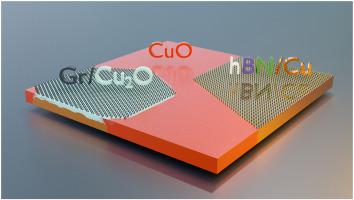Our official English website, www.x-mol.net, welcomes your feedback! (Note: you will need to create a separate account there.)
Comparative study of copper oxidation protection with graphene and hexagonal boron nitride
Carbon ( IF 10.9 ) Pub Date : 2021-01-01 , DOI: 10.1016/j.carbon.2020.09.021 Mattia Scardamaglia , Virginia Boix , Giulio D’Acunto , Claudia Struzzi , Nicolas Reckinger , Xin Chen , Abhay Shivayogimath , Tim Booth , Jan Knudsen
Carbon ( IF 10.9 ) Pub Date : 2021-01-01 , DOI: 10.1016/j.carbon.2020.09.021 Mattia Scardamaglia , Virginia Boix , Giulio D’Acunto , Claudia Struzzi , Nicolas Reckinger , Xin Chen , Abhay Shivayogimath , Tim Booth , Jan Knudsen

|
Abstract The use of protective barriers to isolate a metal surface from an aggressive environment is a common way to inhibit its degradation. We used ambient pressure x-ray photoelectron spectroscopy to assess in real time the evolution of the copper surface and the contextual protective action of 2D material coatings (graphene and hexagonal boron nitride) towards copper oxidation. In an isobaric experiment with 2 mbar of oxygen, the bare copper oxidizes near room temperature, while both 2D materials can retard the onset temperature for the first oxidation of copper by more than 120 °C. However, their protection mechanism is different: boron nitride behaves more straightforwardly, forming an effective barrier to copper oxidation until it is etched away at high temperatures, leading to a rapid oxidation to cuprous and then cupric oxide. On the other hand, graphene reveals to be a more interesting playground underneath oxygen intercalates and begins a slower undercover oxidation of copper. The coexistence between graphene and cuprous oxide, not observed in boron nitride, protects the copper from further oxidation to cupric oxide.
中文翻译:

石墨烯与六方氮化硼对铜氧化保护的对比研究
摘要 使用保护屏障将金属表面与侵蚀性环境隔离是抑制其降解的常用方法。我们使用环境压力 X 射线光电子能谱实时评估铜表面的演变以及二维材料涂层(石墨烯和六方氮化硼)对铜氧化的保护作用。在 2 毫巴氧的等压实验中,裸铜在接近室温时氧化,而两种二维材料都可以将铜的第一次氧化的起始温度延迟 120 °C 以上。然而,它们的保护机制不同:氮化硼表现得更直接,形成有效的铜氧化屏障,直到它在高温下被蚀刻掉,导致快速氧化为亚铜,然后是氧化铜。另一方面,石墨烯显示出氧嵌入下方的一个更有趣的游乐场,并开始较慢的铜的卧底氧化。在氮化硼中未观察到的石墨烯和氧化亚铜之间的共存保护铜免于进一步氧化为氧化铜。
更新日期:2021-01-01
中文翻译:

石墨烯与六方氮化硼对铜氧化保护的对比研究
摘要 使用保护屏障将金属表面与侵蚀性环境隔离是抑制其降解的常用方法。我们使用环境压力 X 射线光电子能谱实时评估铜表面的演变以及二维材料涂层(石墨烯和六方氮化硼)对铜氧化的保护作用。在 2 毫巴氧的等压实验中,裸铜在接近室温时氧化,而两种二维材料都可以将铜的第一次氧化的起始温度延迟 120 °C 以上。然而,它们的保护机制不同:氮化硼表现得更直接,形成有效的铜氧化屏障,直到它在高温下被蚀刻掉,导致快速氧化为亚铜,然后是氧化铜。另一方面,石墨烯显示出氧嵌入下方的一个更有趣的游乐场,并开始较慢的铜的卧底氧化。在氮化硼中未观察到的石墨烯和氧化亚铜之间的共存保护铜免于进一步氧化为氧化铜。


























 京公网安备 11010802027423号
京公网安备 11010802027423号